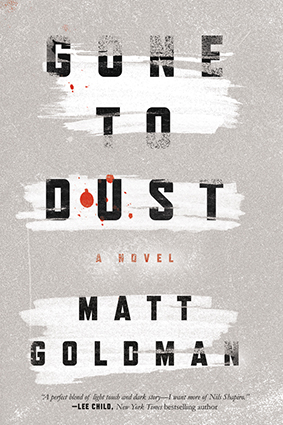opens in a new window opens in a new window
opens in a new window opens in a new window
opens in a new window opens in a new window
opens in a new window opens in a new window
opens in a new window opens in a new window
opens in a new window
A brutal crime. The ultimate cover-up. How do you solve a murder with no useable evidence?
Private detective Nils Shapiro is focused on forgetting his ex-wife and keeping warm during another Minneapolis winter when a former colleague, neighboring Edina Police Detective Anders Ellegaard, calls with the impossible.
Suburban divorcee Maggie Somerville was found murdered in her bedroom, her body covered with the dust from hundreds of emptied vacuum cleaner bags, all potential DNA evidence obscured by the calculating killer.
Digging into Maggie’s cell phone records, Nils finds that the most frequently called number belongs to a mysterious young woman whose true identity could shatter the Somerville family–but could she be guilty of murder?
After the FBI demands that Nils drop the case, Nils and Ellegaard are forced to take their investigation underground, where the case grows as murky as the contents of the vacuum cleaner bags. Is this a strange case of domestic violence or something with far reaching, sinister implications?
Gone to Dust will become available August 15th. Please enjoy this excerpt.
Chapter 1
Minneapolis had a brown Christmas. It happens, sometimes. Store owners complain about not selling sleds, skis, and shovels, but no one else seems to mind. We know what’s coming. And just after midnight on January 4 it did, falling wet and heavy. Eighteen inches on an earth frozen stiff by a clear, cold December.
I decided to give myself a snow day and stayed under the comforter to dream in the gray light, but the dreams never came or maybe they did and fizzled out unremembered. I woke at the crack of 8:55 to a buzzing nightstand accompanied by a medley of plows scraping streets, snow throwers whining under stress, and tires spinning themselves to nowhere.
I answered my cell. “Hello.”
“Shap? You available?” It was Ellegaard.
“Professionally or romantically?”
“Sheesh, Shap. This is serious. East side of Edina near Arden Park. We caught something . . .” He paused. I could tell he was shaken. “ . . . something sick.”
Ellegaard didn’t swear or drink. He wasn’t an alcoholic or Mormon or twelve so he had no excuse. “What happened?” I said.
“Dang it, Shap, just get over here.”
Ellegaard and I attended the Minneapolis Police Academy together. A week after getting our badges, the mayor, fending off a Republican challenger, made a show of cutting costs. Last hired, first fired. While the other layoffees sat on their pimply ones playing video games until the rehiring, Ellegaard and I got industrious. I went to work for a private-detective firm and started accruing hours toward my license. Ellegaard found a police job across France Avenue in the regal suburb of Edina, where the cops worked the most white-collar job you can while wearing a blue collar. Neither of us put on a Minneapolis police officer’s uniform again.
Edina PD spent most of its time camped out at the bottom of a hill on 50th writing speeding tickets to Mercedes and BMWs. The revenue helped pay for consultants when a real crime came Edina’s way and apparently one had—the Edina police hadn’t worked a murder in over a decade.
“We need you, Shap,” said Ellegaard. “Now.”
I owned a shitbox one-bedroom near 54th and Drew. A divorce settlement left me with enough money to pay cash for it. The house was more expensive than it looked—good schools and restaurants within walking distance inflated the neighborhood’s property values. Every week I received at least one offer to buy it, always from a builder. People saw great value in my home, as long as they could wipe it off its foundation.
It’d take me ten minutes to walk to Ellegaard on the east side of Arden Park or an hour to shovel the driveway so I could back my aged Volvo out of the garage and get it stuck in the unplowed alley. “I’ll walk over,” I told Ellegaard. “Save me an acai berry croissant or whatever you Edina hard-asses are eating these days.”
I downed two cups of coffee, threw on a jacket, and laced up my Sorels. I opened my front door. A foot and a half of the heavy stuff pressed against the storm door. I wedged it open just enough to slip outside. It was thirty degrees. Compared to the last few weeks of subzero fuckery, it felt like summer. The plows had only scraped the main thoroughfares, leaving most Minneapolis streets rutted and sloppy. I trudged west on the snow-covered sidewalk then hit a stretch some do-gooder had cleared to justify the grand he’d spent on his snowblower. Then I was Ernest Shackleton again until I reached the Edina border where the suburb’s streets glistened wet and clean thanks to a battalion of overnight plows.
I turned right on Minnehaha Boulevard which hugged the east edge of Arden Park. A massive house on a hill rose to my right. A sign in the yard read VOTE NO SIDEWALKS FOR—Snow covered the remainder of the sign.
On my left, Parks & Rec had already plowed the hockey and free-skating rinks. Shouts and screams and skates and sticks and pucks slapping boards. All comfortable and familiar. Memories of skating with pretty girls with ropey braids and swollen sweaters. It was a youth well spent. I might’ve become nostalgic if I hadn’t seen the flashing police cherries two blocks away through the leafless oaks and maples.
The police gathered outside a gargantuan architectural mongrel bred of colonial, Cape Cod, and tudor, all capped off with an English country–style roof of steam-bent cedar shingles that rounded at the edges like mushroom caps. The place looked like a painting you’d see in an art gallery at the mall. A massive red oak, probably older than the state of Minnesota, umbrellaed the front yard, hundreds of dead brown leaves still clinging to its branches in the January air. The wide driveway was clear and dry, evidence of hot water tubes snaking beneath. That’s where Ellegaard waited for me.
He told the uniforms to let me through the yellow tape. Whole families stood outside and craned their necks. The watercoolers would be abuzz the next day in the executive wings of Target, United Health Care, Cargill, and General Mills. A KARE 11 news van pulled up. They’re the station that cares. Or so it said on the back of their news team parkas.
Ellegaard looked like a Boy Scout, only he’d traded in his kerchief and merit badges for a Brooks Brothers suit. He was a six-foot-three, blue-eyed blond who either shaved twice a day or didn’t shave at all—I couldn’t tell which. He had hair like an anchorman on the six o’clock news, and I wanted to slap him for it. “Chief McGinnis,” he said, “I’d like you to meet Nils Shapiro.”
I pegged the Edina Chief of Police for early-sixties. Craig McGinnis stood six foot five and had the build of a decathlete. He had a full head of silver hair, wore a charcoal suit and a red cashmere scarf. I hoped the scarf was a Christmas present he felt obligated to display rather than an affectation. If it were the latter, he and I were going to have a problem.
“Nils Shapiro,” he said. Shaking my hand like it was the love-tester machine at Bennigan’s. “That’s an unusual name.”
“Yeah, but only Swedes and Jews know it.”
“I’ll bet,” he said. He smiled. “Detective Ellegaard says you’re the best private investigator in Minnesota. Said you cracked the Duluth murders but didn’t get credit for it.”
“I don’t need a lot of attention.”
“I like that in a man. Even more in a woman.” He laughed at his joke but the laughter didn’t last. I guessed whatever was in that house wasn’t going to let him experience much joy for a while. He looked at me and mustered the toughest expression he had in him. “Consultants who work for Edina PD don’t talk to the press. They don’t talk to Minneapolis PD. They don’t talk to the Feds. They don’t talk to their wives, their girlfriends, post on the Internet. They don’t communicate outside of Edina PD. Period. And even though you’re an independent contractor, if you break our chain of command, you’re gone. Understood?” I nodded. “How much do you charge?”
“Five hundred a day plus expenses.”
“Expensive, but I suppose you’re going to tell me I get what I pay for.”
“Well, I don’t know about that. But the more I charge the less my employer tends to waste my time.”
McGinnis looked to Ellegaard for assurance. Ellegaard gave him a nod.
“All right,” McGinnis said. “Take him inside.”
Ellegaard led me up the walk toward a pair of double front doors. “We’re not going in this way,” he said, “but I want you to see something.” He put on a latex glove and knocked on a massive slab of oak. A voice from inside told him it was okay to open it, and Ellegaard did with a gentle nudge.
I looked inside. A thick coating of grayish dust blanketed the foyer. It didn’t look like natural dirt, and any normal human being would have cleaned it up. “Someone murder the maid?”
“Don’t joke,” said Ellegaard. “That dirt is why you’re here.”
“Any idea what that shit is?”
“The consensus at the moment is it looks like what you’d find inside a vacuum cleaner bag—you know, when it’s full and you have to change it.”
Then I felt it, the lightness, the excitement, as if I’d discovered a sealed box in my basement I’d never noticed before. I’d felt it in Duluth. I’d felt it on my first date with Micaela. I’d felt it as a boy the first time I heard Nirvana’s “Lithium.” And I knew I was about to experience something significant well before I knew what that thing was or whether it would be good or bad.
“The M.E. is upstairs in the master suite with the body,” said Ellegaard. “Other than that, CSU has stayed outside. They’re afraid they’ll make matters worse.”
“How could they make matters worse?”
“That dirt or dust or whatever it is, it’s all over the house. It continues up the stairs and down a hall and into the master suite and leads right up to the body, which is . . . Well, you’ll see. CSU isn’t quite sure what to do with it.”
I looked over my shoulder and saw the CSU team standing outside their van, sipping coffee and looking uncomfortable and unsure. Each one of them probably had the same expression at prom. “What are you saying, Ellie? The crime scene’s so contaminated they’re afraid they’ll uncontaminate it which will, in effect, further contaminate it?”
“Don’t call me Ellie,” he said. “That nickname didn’t come with me to Edina. I don’t want it to start now. And yeah, something like that. We don’t even know how to begin on this.”
We walked away from the front doors and into the garage, where a dozen paper yard bags sat filled with leaves awaiting pickup in the spring. We entered the house through the garage service door. Ellie hadn’t oversold it—the dusty dirt was everywhere. Gray and fluffy. In the mudroom. In the kitchen. Ellegaard put sanitary shoe covers over his loafers. I took off my boots and put the sanitaries over my socks. We headed upstairs, looking down on the living room that featured a grand piano. Of course it did. This was the kind of neighborhood where every parent makes their kid take piano lessons but no parent wants their kid to be a musician.
If the fluffy gray stuff hadn’t blanketed the master suite, it would have been immaculate. A king-sized four-poster of the Shaker persuasion was the main attraction centered between nightstands and wall sconces. Framed photographs of children, from babies to preteens, sat on the nightstands and floating shelves. A chaise longue took up space, but not enough. The room was so big you had to be in shape to get from one piece of furniture to the next. A wall of windows offered a view of the acre-sized backyard bordered by the Minnehaha Creek, now frozen and covered in snow. You could sit in a cushioned window seat if it was too exhausting to stand while looking out at all that beauty.
Only the mummy-shaped pile of dust on the bed seemed to be at odds with the interior decorator’s grand vision. A thermometer stuck out of it at an odd angle, and the M.E. stood over it. Julie Swenson. She usually worked on Minneapolis bodies. I’d met her a few times at the Hennepin County morgue. She had long gray hair and eyes with a hint of blue. I guessed she was over fifty. I usually stuck to south of forty like myself, but something about the honesty of her hair tempted me to fall in love with her. Maybe I’d tell her one night in the cold room when she wasn’t holding the bone cutter.
“There’s the body,” said Ellie, pointing to the sarcophagus of dust with the thermometer sticking out of it.
“No shit,” I said, turning away from the look I knew Ellie was giving me. “Hey, Julie. You moonlighting in Edina?”
“I am while their M.E. is in Fiji. Pleasure seeing you here in the hamlet, Nils.” Her eyes didn’t mean it though, and I ditched my plans for romance in the cold room.
Julie Swenson pulled the thermometer from the dust-covered body. She tapped her fingers on an iPad then estimated the time of death between 11:30 P.M. and midnight.
A uniform led a neighbor into the bedroom. “This is Beth Lindquist from around the corner on Bruce Place,” said the officer. “She can ID the body.”
“I think I can,” said Beth, small and timid. She sniffled. “But I don’t know . . .” She had shoulder-length dark hair, a slender frame, slightly stooped shoulders, and a neck that appeared too thin to hold up her head, especially with her face swollen from crying. I guessed Beth was in her midforties, but she seemed ten years older than that, as if she’d modeled her image on a woman in her mother’s generation. No one, I guessed, had ever called Beth Lindquist a firecracker, but plenty of people had called her ma’am. “I don’t know if I can handle seeing—” Beth stopped and, for the first time since entering the room, noticed the dust-covered body on the bed. She shuddered.
Ellie stepped toward her. “Mrs. Lindquist, I’m Detective Ellegaard. I know this is difficult. But we’d greatly appreciate your help, so please, take as much time as you need.”
Beth Lindquist nodded, shut her eyes and inhaled slowly, held the breath and then exhaled—a move she learned in yoga, no doubt. Then she nodded. Goddamn Ellegaard. His power on women was like a microwave’s on a marshmallow—too bad he’d married young.
Beth moved forward in small steps like she was a hundred and two. Julie Swenson brushed away some dust and exposed the gray face of a woman with eyes closed. Wisps of blonde hair looked especially yellow next to her colorless skin. Beth Lindquist screamed, dropped to her bony knees, and whimpered, “Poor Maggie. Poor, poor soul.”
Copyright © 2017 by Matt Goldman
Order Your Copy
opens in a new window opens in a new window
opens in a new window opens in a new window
opens in a new window opens in a new window
opens in a new window opens in a new window
opens in a new window opens in a new window
opens in a new window







